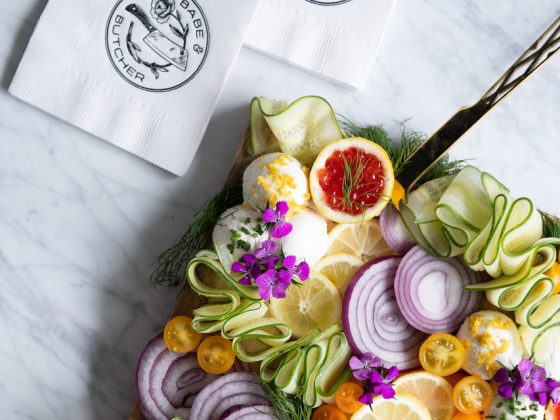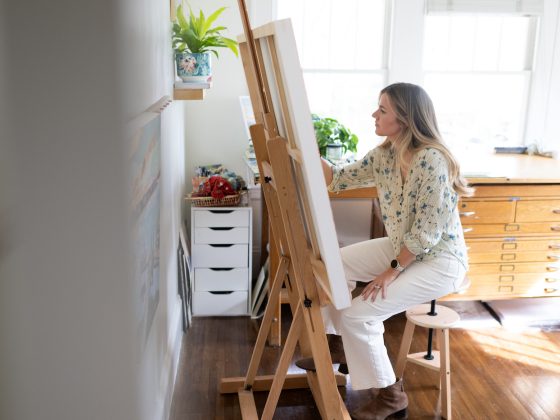In October, Charlotte got a little bit niftier when internationally-renowned artist Hunt Slonem passed through town. A recipient of numerous awards and grants, Slonem first appeared on the art scene in the 1970s while living in New York alongside cultural icons like Andy Warhol, Sylvia Miles, and Cookie Mueller. Today, Slonem’s pieces can be found in the permanent collections of 250 reputable museums, galleries, and institutions around the world, including the National Gallery of Art in Washington D.C., the Metropolitan Museum of Art in New York, and the Museum of Fine Arts in Boston. His work is on display at the New Gallery of Modern Art in Charlotte until November 15th.
Read on to learn about Slonem’s unusual childhood, artistic processes, and eccentric hobbies.
Tell us about your early life.
I grew up in a military family. I lived in Hawaii in the sixties, while I was in elementary school. There was a wonderful mixture of cultures where I lived. I went to school with kids from Samoa, Fiji, the Philippines, Japan, and China – a real melting pot. There was a guy named Captain Henry who lived across the street and had a rainforest; we used to help him in the afternoons. Another neighbor, Captain Bell, had piranhas. It was a magical place. Since then, I’ve surrounded myself with what I paint.
We left Hawaii the day Marilyn Monroe was found murdered – the day she died, let me rephrase that. From there we moved to Virginia. California, Washington, New Hampshire, and Connecticut followed. I was also an exchange student in Nicaragua in high school. Now, I seem to have this ingrained need to move all the time.
What remained constant was that I really wanted to be a painter. I thought I was Gogan as a little kid. When I was in first grade we had to draw a picture of what we wanted to be when we grew up and I drew myself at an easel painting. So I was never conflicted about what I wanted to do. It was just a matter of doing it.
Where do you find inspiration?
I have sixty pet parrots that are very noisy. They’re family. Everybody else is not. They’re highly intelligent, so you have to talk to them. We have a bird that flew away twice and twice we got him back. It’s a male parrot named Nepaulo. We have no idea how he gets out. One of my mystics thinks he has special powers. Anyway, the birds are all part of my painting process. You used to be able to tell a real from a fake of mine by whether there was bird shit on it.
So, that’s the birds. As for the rabbits, I’m the sign of the rabbit. I found out late one night at a Chinese restaurant. I always used to paint the same paintings and there was always a family of rabbits in the foreground. I played with a lot of animals and the bunny kept reappearing.
What is your artistic process?
I used to do much more complicated storytelling in my painting. Then, I started leaving figures out and just painting jungles with the animals in them, like in my series All About Eden. The older you get, the more you’re willing to leave out. Forty years ago, I would never have dared to do some of the things I do now.
The biggest transformation in my process was starting to paint wet into wet, which was inspired by a change in my frames. I was doing a show at Virginia Commonwealth University and the curator wanted me to frame my paintings. I couldn’t afford contemporary frames, but I’d been going to a flea market and found that a lot of the empty photo portrait frames fit my style. I love doing these salon style hangings. So painting wet into wet followed. It took me away from using a little dab of paint out of the tube, a drop at a time, and instead I started buying gallons of paint. My whole format changed.
Then, I began to carve into my paintings. I lived for 24 years with a 40-foot birdcage surrounding me, so I saw everything through a mesh. One day, after one of my first trips to India, I picked up the back of the brush and started making marks like the bars of a cage. People often refer to the cages in my paintings as if they’re surrounding the subject, but who knows who the cages are in front of. Maybe we’re on the wrong side of them and the subjects are on the right side. It’s not obvious.
I was thinking of maybe Agnes Martin, maybe Chuck Close when I started doing making the marks. It became this almost mantra-like gesture, a very contemporizing way of incorporating what I’m doing into another realm. It was one of those moments in time when a whole bunch of things fell into synchronicity. It opened a lot of doors for me, and it reminded me of ancient painting, like mosaics.
Do you have other outlets for your creative energy in addition to painting?
Picasso was a tremendous influence on me, not because of his art but because of his house collecting. He bought chateau after chateau and that really spoke to me as a child. He wouldn’t sell them, just fill them with art and then go buy another one.
So, I collect historic homes. I think I’m up to five or six now – Louisiana plantations, a mansion overlooking the Hudson, an armory in Scranton, the F.W. Woolworth mansion, a few others. I continue to make new connections with places where I dwell and work. It gives me new inspiration and ideas. It’s just part of the passion. It’s not a unique hobby in the artist world.
Once, Jackson Pollack’s great-grandson asked me how I can own plantation homes given the suffering that happened there. I reminded him that the Coliseum in Rome is frequently visited but has a history much worse than my plantations. Time heals all, and maybe the reverse comes true – my plantation homes are so beautiful and peaceful and quiet. That’s part of my mission: to make sacred spaces and uplift.
I’ve done clearings to try to uplift any not great energies that might be residing in my houses. When I realized there was a ghost in my armory, I worked with a metaphysician who figured out that the ghost was a very ancient spirit, almost a goddess, who was distressed by the trauma attached to some of her artifacts. The ghost wanted to appear and thank me for turning so much darkness into light.
What are you working on right now?
I love doing 50-foot paintings. I’ve done several series of very large paintings of bunnies and birds. Three went to Russia permanently. I feel like I’m really at my best on the largest scale possible. My hope is to do larger and larger paintings.
I’ve also been doing sculpture for years, and I’ve had the opportunity to do seven or eight monumental sculptures in Louisiana recently. I’ve been making cats and wooden things in the studio for years that have been shown occasionally, but these newest sculptures were specifically commissioned for certain projects.
What do you think of Charlotte and the New Gallery, where your art was exhibited in October?
This is my second or third time at the New Gallery. I think it’s great. This is my fifth or sixth time to Charlotte. I love coming to Charlotte and cities like this. It’s the best of America. I love Cincinnati and Kansas City, too…there’s a lot to this country that is not solely in New York.












